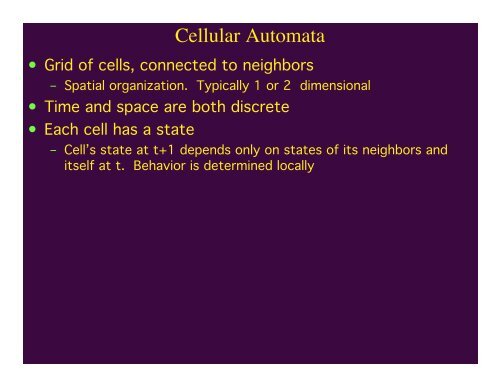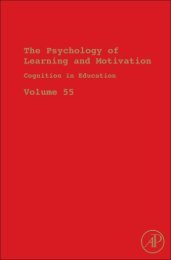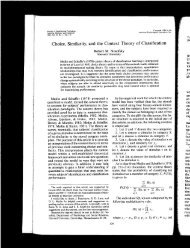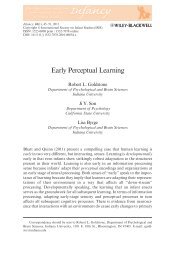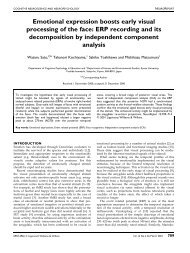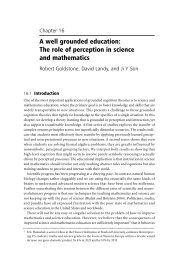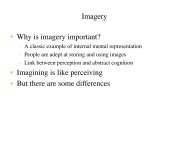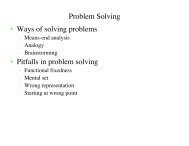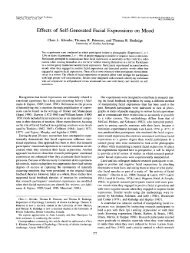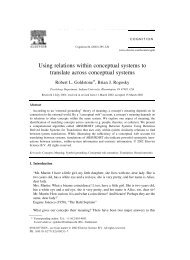Cellular Automata
Cellular Automata
Cellular Automata
- No tags were found...
Create successful ePaper yourself
Turn your PDF publications into a flip-book with our unique Google optimized e-Paper software.
<strong>Cellular</strong> <strong>Automata</strong>• Grid of cells, connected to neighbors– Spatial organization. Typically 1 or 2 dimensional• Time and space are both discrete• Each cell has a state– Cell’s state at t+1 depends only on states of its neighbors anditself at t. Behavior is determined locally
• I: Steady state at end• II Repetitive cycleWolfram’s Classification Scheme• III: Random-like behavior– Rule 30– Cannot compress behavior (other than by using Rule 30)• IV: Complex patterns with local structures that move throughspace/time– Edge of Chaos? (Langton, Crutchfield, Kauffman)– Langton’s Lambda parameter• Number of rules producing a live cell/Total number of rules– Not too rigid and not too fluid– Information can be effectively transmitted
Type 1: Steady-state Patterns
Type 2: Repetitive Cycles
Type 3: Random-like patterns
Type 4: Local Structures that Move
Langton’s Lambda Parameterl=10/32, Type IIl=12/32, Type IVl=14/32, Type III
Rule 30 (Wolfram, 2002)This rule produces complex patterns with eventhe simplest initial condition (one “on” cell)
Sensitivity to initial conditionsRule 22Rule 30Changing one cell in initial seed pattern causes acascade of changes
<strong>Cellular</strong> <strong>Automata</strong> Terminology• Cell-space: define a lattice structure with maximumextent of n columns and m rowsm{ }L = (i, j) | i, j Œ N,0 £ i < n,0 £ j < m• Moore neighborhood: N, S, E, W and diagonal neighbors†N i, j= {( k,l) Œ L k - i £1and l - j £1}n• Von Neumann: only N, S, E, W cells†N i, j= k,l{( ) Œ L k - i + l - j £1}†
• Totalistic rules<strong>Cellular</strong> <strong>Automata</strong> Terminology– the state of the next state cell is only dependent upon the sum of thestates of the neighbor cells• Reversible rules– No application of the rules loses any information– For every obtainable state there is only state that can produce it– Atypical, because these do not incorporate cell interactions– Sometimes applied in modeling physical systems (e.g. billiard balls)
• Mobile automata<strong>Cellular</strong> <strong>Automata</strong> Broadened– A single active cell, which updates its position and state• Turing Machines– The active cell has a state, and states determine which transition rule isapplied• Substitution Systems– On each iteration, each cells is replaced with a set of cells• Tag systems– Remove cells from left, and add to the right depending on removed cells• Continuous state systems– On each iteration, each cells is replaced with a set of cells• Asynchronously updating systems
Mobile automata
Turing Machines
Substitution System
Cantor’s Set
Fractals• Self-similarity at multiple scales• Formed by iteration• Fractional dimensionality– The Cantor set: replace every 1 pattern with 101 with same length– Cantor set = the points remaining 1 when this is applied infinite times– Infinite number of points, but no length– A = measure of a measuring device– An object Dhas N units of measure AÊN =1 ˆÁ ˜Ë A¯D= dimensionalityD = log(N)Êlog 1 ˆÁ ˜Ë A¯If A= 1/3 and D =2, N=9†If A= 1/3 and D =1, N=3†
Cantor’s SetA = 1/3, N= 2, so D=log(2)/log(3)A = 1/9, N= 4, so D=log(4)/log(9)ÊA = ÁË1 3 Tˆ˜ , N = 2 T ,D =¯( )( ) = T log(2)log 2Tlog 3 TT log(3) @ 0.6309Dimensionality is between 0 and 1†
Hilbert’s Space Filling Curve• Dimensionality = 2 as iterations go to infinity eventhough it is a single line• Fractals: measure of object increases as the measuringdevice decreases
2-D substitution systems
L-Systems for plant growthSubstitution system
Continuous StatesDiffusion = every cell takes on the average of itself and its two neighbors
Continuous States and Space
Discrete transitions from continuous systemsOrder from random configurationsApparent randomness from orderly configurations
Crystal FormationWhen ice added to snowflake, heat is released, whichinhibits the addition of further ice nearby<strong>Cellular</strong> automata: cell becomes black if they have exactlyone black neighbor, but stay white if they have more thanone black neighbor
Crystal Formation
Shell formation (following Raup)
Model-world comparison
Plant Formation
Pine Cone SpiralsThe numbers of clockwise and counter-clockwisespirals are successive numbers in the Fibonaccisequence: 1 1 2 3 5 8 13 21 34 55The angle between successive leaves on the pinecone is 137.5 degrees
C=1Golden MeanACA = AC - AAC-AC 2 -AC=A 2A 2 +A-1=0
AC=1C-AThe Golden SectionFind the A such thatCA = AC - AC 2 -AC=A 2A 2 +A-1=0Golden Rectanglef1
The Golden SectionThe angle between successive sunflower seeds is thegolden section of a circleThe ratio of successive numbers of a fibonacci sequenceapproximate ff=.6180… 3/5=.6 8/13=.615 34/55=.6182
The Golden Section in PlantsSo, are sunflowers good mathematicians?No, 137.5 degrees emerges from simple interactionsamong plant leaves/seeds
Sunflower Seed Interactions1
Sunflower Seed InteractionsNew seed is positioned maximally as far away fromexisting seeds as possible.21
Sunflower Seed Interactions231Seeds 1 and 2 both push Seed 3 away, but Seed 2 pushes morebecause it is closer to Seed 3.Find location on circle for seed that minimizes the sum of the“push” exerted by other seeds, where push is an inverse squarefunction of distance
<strong>Cellular</strong> <strong>Automata</strong> in Shell Patterns
Pattern Formation
Pattern Formation (Morphogenesis)• Spots and Stripe formation• Activator-inhibitor systems– Cells activate and inhibit neighboring cells– Close neighbors activate each other– Further neighbors inhibit each other– Mexican hat function in visionInfluence on cellDistance from cell
Turing’s Reaction-Diffusion Model• Show how patterns can emerge through a self-organizedprocess from random origins• Each cell has two chemicals– Chemical A is an autocatalyst - it produces more of itself– Chemical B inhibits production of A• Diffusion: each chemical spreads out• Reaction: each chemical reacts to the presence of theother chemical and to itself• Activator chemical diffuses more slowly than inhibitorchemical• If there is local variation in chemicals and chemicalamounts do not increase without bound, then stablestates of inhibitor and activator chemicals are found
Turing’s (1952) Reaction-Diffusion ModelReactionDiffusionA+-Breactiondiffusionion
A difference equation account of diffusionx i-1x i x i+1a=f(x) a i-1 a i a i+1Da/Dxa i - a i-1a i+1 -a iD 2 a/Dx 2(a i-1 +a i+1 )-2a iD 2 aDx 2 = a i-1 + a i +1 - 2a ita +1 tx,y= a x,y+ DtD (taa x +1,y+ a tx-1,y+ a tx,y +1+ a ttx,y-1- 4a ) x,y
Pattern Formation with activator-inhibitor system
Stripe formationGreater diffusion in one direction than the other
<strong>Cellular</strong> <strong>Automata</strong> for Animal Pigmentation PatternsMurray (1993)
<strong>Cellular</strong> <strong>Automata</strong> for Animal Pigmentation Patterns
Diffusion Limited Aggregation for Population Growth


